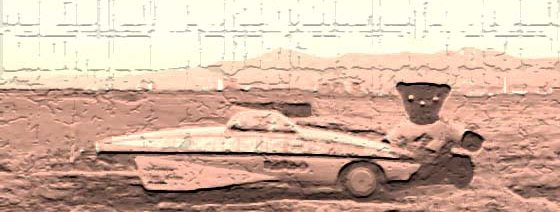===== Foreword =====
Solar panels, a motor, electric circuits, and mechanical components are detached by the solar car that became old. And they will be recycled to produce a new solar car.
To recycle transparency films made of nitrocellulose, many of the work of early movies have been lost. Similarly, a lot of solar cars do not leave their shape to future generations excluding historical solar cars that have been exhibited in the museum etc.
In 1989, Solar Car Design Grand Prix was held in the Nagoya Design Expo. Asahi Solar Car Rally was held in Kobe in the same year. Thereafter, a lot of solar car events have been held in Japan. We can be able to get informations on Solar Car Race Suzuka and World Solar Car Rallye in Akita from world wide web. However, we can find only some fragments of other solar car events to solar car team's web sites the article on the local press. They have been buried in the mountain of enormous information.
I wanted to trace footprints of great solar car pioneers in the 20th century. At that time, I learnt the book on the history of the Japanese solar cars were very little. I tried to connect the fragment obtained from web, articles in newspapers, magazines, books and other references and to write the history of solar cars. I knew the work was severe and very hard. I felt that the work looked like archeology.
I do not expect the day when this site is completed. Therefore, I will write the article little by little and add to this site.
I wish that this site be useful for searches information on the Japanese solar cars.
Satoshi Maeda @ Solar Car Archaeology Research Institute
*************************************************************
===== The History of Solar Cells =====
1839 in French
Edmund Becquerel, a young physicist, discovered the photovoltaic effect while experimenting with an electrolytic cell made up of two metal electrodes. It was a basic phenomena for wet type solar cells.
1876 in United Kingdom
Adams and Day observed the photovoltaic effect in solid selenium.
1883 in USA
Charles Fritts, an American inventor, described the first solar cells made from selenium wafers. The device is used for the exposure meter of the camera.
1918 in Poland
Polish scientist Czochralski developed a process to grow single-crystal silicon. The process is used for silicon monocrystalline manufacturing as Chocrasske method.
1947-1952 in USA
AT&T, Bell Laboratories, basic theory, proof experiments, and patent applications, for the transistor with PN junction.
1954 in USA
AT&T Bell Labs researchers D. M. Chapin, C. S. Fuller and G. L. Pearson reported their discovery of 4.5% efficient silicon solar cells. The efficient was raised to 6% only a few months later.
1955 in USA
Antimonopoly Law did not permit AT&T to monopolize of the semiconductor technology. Western Electric began to sell commercial licenses for silicon PV technologies. Hoffman Electronics's Semiconductor Division announced a commercial PV product at 2% efficiency; priced at $25/cell and at 14 mW each
1957 in USA
"Solar Energy Converting Apparatus," patent US2780765 was issued to Chapin, Fuller, and Pearson, AT&T. Hoffman Electronics achieved 8% efficient cells.
The first space satellite "Vanguard I" equipped with solar cells was launched. However, the rocket that put it exploded immediately after the launch.
1958 in USA
The United States succeeded in the launch of Explorer 1. The satellite operated with the solar cell for 112 days.
1959 in Japan
Sharp Corporation started the solar cell research.
1960 in USA
Hoffman Electronics achieved 14% efficient PV cells.
1963 in Japan
Sharp Corporation succeeded in producing practical silicon solar cells.
1964 in USA
The Nimbus (earth observing satellite) was launched with a 470 watt solar cells. It stopped operating by the solar cell damage in one month.
1965 in USA
Tyco Labs developed the edge-defined, film-fed growth (EFG) process, first to grow crystal sapphire ribbons and then silicon.
1966 in USA
OAO-1: The Orbiting Astronomical Observatory was launched with 1 kW solar cells. The missions were observation of ultraviolet, X-ray and gamma ray emission. It stopped two days later due to the breakdown of the power system.
1966 in Japan
242 watt Sharp solar panels were installed on a lighthouse on Ogami Island Nagasaki Pref. It was the world's largest array on the earth at that time.
1973 The First Oil Crisis
The fourth Middle East war broke out on October 6, 1973. The crude oil price rised greatly.The economy of Japan and the industry that had depended on crude oil from Arab were faced to a big crisis.
1974 in USA
Tyco Labs grew the first EFG, 1-inch-wide ribbon by an endless-belt process.
1974 in Japan
Japan Ministry of International Trade and Industry Agency of Industrial Science and Technology. The Sunshine program that promoted the petronium alternative energy development was begun. Six companies (Hitachi, Toshiba, NEC, Sharp, Matsushita, and the Toyo silicon)
1975 in Japan
Sharp proposed the FEG process to Agency of Industrial Science and Technology with Kyocera that was licensed from Tyco labs. Their proposals were rejected. Sharp, Kyocera, Matsushita, Mobile (U.S.), and Tyco Labs(U.S.) established "Japan solar energy company (JSEC)" for developing FEG process.
1976 in USA
D.E. Carlson and C.R. Wronski reported the fabrication of an amorphous silicon p-i-n solar cell with a conversion efficiency of 2.4%
1977 in USA
The Solar Energy Research Institute (SERI), later to become the National Renewable Energy Laboratory (NREL), began operating.
1978 The Second Oil Crisis
Iranian Revolution in 1978. The oil production in Iran interrupted, and oil supply was stringent to Japan that had bought a large amount of crude oil from Iran. The crude oil price was raised up again. In Japan, The development of the amorphous silicon solar cell was included in the Sunshine Program.
1980 in Japan
NEDO (New Energy Development Organization) was established. The research on the oil alternative energy use that contain the solar cell was promoted. The world's first commercial production of amorphous silicon solar cells were made by Sanyo Electric.
1982 in Japan
Kyopcera Corp. began the mass production of polysilicon solar cells.
1982 in Australia
In December 19, We faced the memorial day that Hans Tholstrup and Larry Perkins started on a historical trans-continental touring.
資料
*1)http://www.pvresources.com/en/history.php
*2)http://www.geocities.com/semnews/milestones.html
*3)http://inventors.about.com/library/inventors/blsolar2.htm
*4)http://www.ecopo.ec.kagawa-u.ac.jp/tetsuta/semicon/semicon1.html
*5)http://ncst-www.nrl.navy.mil/NCSTOrigin/Vanguard.html
*6)http://www.californiasciencecenter.org/Exhibits/AirAndSpace
/MissionToThePlanets/Explorer1/Explorer1.php
*7)http://www.sharp.co.jp/sunvista/about/history.html
*8)http://sharp-world.com/corporate/info/his/h_company/1963/index.html
*9)川鉄テクノリサーチ株式会社,「国家プロジェクトの運営・管理状況分析調査報告書 I」,2001.03.
http://www.meti.go.jp/policy/tech_evaluation/ e00/01/h12/h1303i29-1.
*10)島本実,「ナショナルプロジェクトの制度設計―サンシャイン計画と太陽光発電産業の生成―」,
一橋大学博士論文要旨,1998. http://www.cm.hit-u.ac.jp/kyouiku/mcm/thesis/shimamt1.html
*11)http://www.kyocera.co.jp/prdct/solar/spirit/history/75-81.html
*12)http://www.kyocera.co.jp/prdct/solar/spirit/history/82-86.html
*13)http://www.nhk.or.jp/projectx/184/index.htm
*14)http://www.dentaku-museum.com/calc/calculator/first/solarcell/solarcell.html
*15)http://www.sanyo.co.jp/clean/solar/hit_e/index_e.html
*16)http://www.kanekaeng.co.jp/solar/index.htm
*17)http://www.nedo.go.jp/english/index.html
*************************************************************
===== Which was the First Solar Car ? =====
I know seven "The first solar car"s.
United States in August 31, 1955
A small solar car that made by William G. Cobb of GM Co. was demonstrated in Chicago. 12 selenium cells were installed in the car. The total length of the car was only 15inch(38cm). A small motor of the car was driven by photocurrent. And, small Pooley drove the rear wheel shaft. Of course, the person was not able to take the car. This small car was a great trial for the solar vehicles. but I hesitate to call it "Solar car" a little. *1) *1a)*2)
United States in 1962
The International Rectifaia Co. opened to the public a solar car. The car was the Baker Electric car (vintage electric vehicle made of 1912 years) that equipped with 10640 solar cells on the roof deck. There is no description of having actually run. *3).*3d)*3e)
United States in 1977
Professor Ed Passereni at Alabama University produced solar car "Bluebird". The car was neither a model car nor a remodeling on the market car. The design of the car intended to move only by the energy from solar cells. *4a)*4b)*4c)*4d)*4e)
Passereni got a hint from a small European electric three wheel vehicle. *6) Bluebird was exhibited to 1982 world fair (Knoxville,Tennessee : May 1-October 31,1982) held with "Energy Turns The World" as the theme. *7)*8)
United Kingdom 1979-1980
British people Alain Freeman produced the solar car. The car obtained the permission to run in the public road in 1980 the next day. The Car was a small three wheel car with the solar panel roof. *9)*10)
Israel in 1980
The group of the Arye Braunstein professor of Tel Aviv university Department of Engineering produced a solar car.The car had a metal frame and polyvinil body, and 432 solar batteries (400w) were installed. The weight of the car was 1320 pounds (about 600kg). The car controlled the power-supply voltage by the switch and the relay in two stages (24/48volt). The car was driven in 48volt when accelerating, and it was driven in 24 volt when regular running. *11)
Japan in 1979-1980
Prof. Fujinaka at Tokyo Denki University produced a solar bicycle and a solar car in 1979-1980. It was one of "The first solar car". After oil crisis, Prof. Fujinaka started the research of the solar car. The first, He remodeled a bicycle, and produced a solar electric bicycle. Next year, a solar electric vehicle that combined two bicycles was produced. His solar vehicle was so-called separates type solar vehicles that the solar panel and the body were separate. *14)*15)*21)
Japan in 1982
Mr.Hajime Yamawaki (HamaZero) made a solar and gasoline hibrid eco-run car "Sunshine". It debuted at Suzuka Mileage Marathon. The solar erelectric power is used for the engine starter motor.In addition, Mr. Yamawaki remodeled the dynamo part of the engine attachment to the motor. *22)*23)*24)*25)
United States in June 1984
The website of Solution in Solar Electricity described the first Guinness Record was a solar car that Joel Debiddoson and Greg Johanson produced. The vehicle was a pure solar car that did not use the battery. This description is written as an article on the Guinness record establishment on the 25th anniversary. However, the author was not able to find this description to the Guinness Book (English version) published in 1993. The Guinness book said GM Sunraycer's maximum speed 78.37 km/hr (without battery) and Star Micronics Solar Star's maximum speed 135 km/hr (with battery) in the paragraph of Solar Powerd Road Vehicle. *16)*17) There is no description concerning the solar car in a Guinness Book Japanese version in 2005.
資料
*1) http://www.todayinsci.com/cgi-bin/indexpage.pl?http://www.todayinsci.com/8/8_31.htm
*1a) http://www.history.com/this-day-in-history/william-cobb-demonstrates-first-solar-powered-car
*2) 1955 Aug 31, 1st sun-powered automobile demonstrated, Chicago, Ill.(YN, 8/31/99)
http://timelines.ws/20thcent/1955.HTML
*3a)http://www-cchs.ccsd.k12.wy.us/cchs_web/jiliff/Decades/cars/cars.html
*3b)http://www.hbci.com/~wenonah/history/edpart6.html
http://www.hbci.com/~wenonah/history/edpart6a.html
*3c)http://www.irf.com
http://www.irf-japan.com
*3d) http://www.irf.com/60anniversary/
*3e) http://www.irf.com/beta/investor/files/A_True_Rags.pdf
*4) http://www.cw.ua.edu/vnews/display.v/ART/2002/04/29/3cccbf3a6e706
*4a) http://www.edpasserini.com/news/news.htm
*4b) http://www.speedace.info/bluebird_1977.htm
*4c) http://rze-falbala.rz.e-technik.fh-kiel.de/~waller/ftp/solarseminar/ss02/Vortrag3.pdf
*4d) http://users.ira.sch.gr/kampanarakis/iliako_autokinito.pdf
*4e) http://esrenovable.blogspot.com/2008_07_01_archive.html
*5) http://home.eckerd.edu/~pavbd/Energy.html
*6) http://www.cw.ua.edu/vnews/display.v?TARGET=printable&article_id=3cccbf3a6e706
*7) http://greenprints.org/home/sfpubs/sfjv497/nowengin.html
*8) http://users.vnet.net/schulman/1982/fair.html
*9) http://www.speedace.info/alan_freeman_solar_car.htm
*10) http://www.bvs.org.uk/text.HTML
*11) http://www.motherearthnews.com/library/1980_September_October/Israel_s_Solar_Powered_Car
*12) 藤中正治,「地球にやさしいソーラーカー(ハイテク選書ワイド)」,東京電機大学出版局,(1991.03.30)
*13) 藤中正治, 「ソーラー電気自動車のおはなし」, 日本規格協会, p99-101, 1994.08.05
*14) 藤中正治, 「エレクトリックエンジンカー」, 東京電機大学出版局, p162, 2003.11.10.
*15) ぷりずむ「太陽電池自転車」, 朝日新聞(東京本社版), 1980.09.27(孫引)
*16) http://www.solarsolar.com/suncar.html
*17) The Guinness Book of RECORDS 1993, Guinness Publishing
*18) 「電気自動車の時代」,読売新聞社, 1991.12.24.
*19) 第39回東京モーターショー配付資料「ELIICA」,慶応義塾大学,2005.
*20) http://www.eliica.com/
*21) 「ソーラー研究会 神戸で初会合開く」,日刊自動車新聞,1989.09.09,
*22) 山脇一氏インタビュー(2006.10.06.) 掲載紙誌捜索中
*23) 太陽エネルギー, vol..14,No.2, 通巻64, p.34, 太陽エネルギー学会, 1988
*24) クルマニア(確認中)
*25) モノマガジン(確認中)
第一稿 2006.01.01.
追記 2006.09.24.
追記 2006.10.14.
一部訂正 2007.08.07.
引用ウエブサイトについて更新 2010.10.05.
Under Construction
*************************************************************
===== PV Chronology =====
Chronology / Development of the Solar Cells and the Early Solar Cars
===========================================
 TOYOTA RaRa II ,1/12 scale model
TOYOTA RaRa II ,1/12 scale model
The Solar Car Archaeology Top
Copyright Satoshi Maeda@Solar Car Archaeolgy Research Institute
2006.01.01


